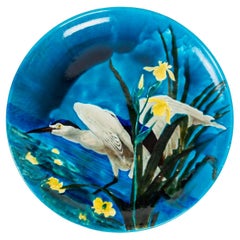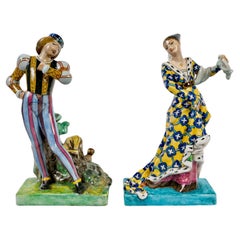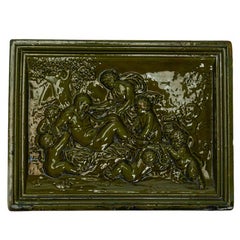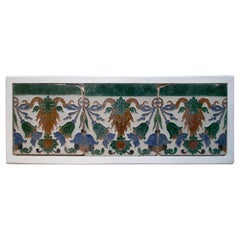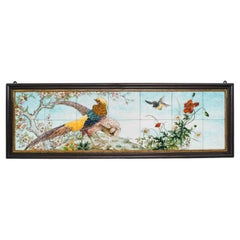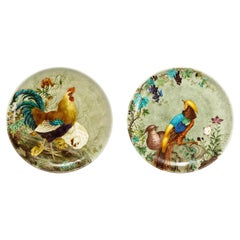Theodore Deck Wall Decorations
to
3
3
3
Height
to
Width
to
3
3
3
3
3
3
3
3
3
14
436
301
286
282
Creator: Theodore Deck
Théodore Deck (1823-1891), an Impressive 19th Century Faïence Charger
By Theodore Deck
Located in Saint-Ouen, FR
Théodore Deck ( 1823-1891)
Impressive polychromed circular faience charger with hand-painted enameled design of a wader among water lilies and reeds.
Impressed Uppercase Mark Th.Dec...
Category
1870s French Japonisme Antique Theodore Deck Wall Decorations
Materials
Faience
$6,464 Sale Price
50% Off
Théodore Deck (1823-1891), Courtly Love, Rare Pair of Faience Figures , c.1860
By Theodore Deck
Located in Saint-Ouen, FR
Théodore Deck (1823-1891)
Courtly Love
Polychrome enamelled earthenware
Pair of subjects representing two lovers in the Middle Ages
Each signed below with the stamp “Th.Deck”
Extr...
Category
1860s French Renaissance Revival Antique Theodore Deck Wall Decorations
Materials
Faience
$15,084 Sale Price / set
30% Off
"Swallow" a Théodore Deck (1823-1891) Framed Enameled Faïence Plaque
By Theodore Deck
Located in Saint-Ouen, FR
Théodore Deck (1823-1891) Swallow
A 19th Century French Square Wall Plaque
Polychromic Earthenware very finely hand-painted, designed with a flying swallow
Impressed mark on the reve...
Category
1870s French Japonisme Antique Theodore Deck Wall Decorations
Materials
Faience
$3,411 Sale Price
25% Off
Related Items
Burmantofts Faience Bacchanalian Green Glazed Tile
By Burmantofts Pottery
Located in Bishop's Stortford, Hertfordshire
A scarce Burmantofts Faience Bacchanalian tile of rectangular form modelled in relief with figures attending to a resting man set within a raised stepped edge and decorated in green ...
Category
1880s English Antique Theodore Deck Wall Decorations
Materials
Faience, Ceramic
Set of Three 19th Century Spanish Hand Painted Glazed Ceramic Patterned Tiles
Located in Marbella, ES
Set of three 19th century Spanish hand painted glazed ceramic patterned tiles
Dimensions exclude frame.
Category
19th Century Spanish Antique Theodore Deck Wall Decorations
Materials
Ceramic
$1,077
H 16.34 in W 5.32 in D 0.79 in
Small 19th Century Majolica Palissy Fish Wall Platter
By Thomas Victor Sergent
Located in Austin, TX
Rare small Palissy platter with a fish, lizard, butterfly, ivy leaves attributed to Thomas Sergent.
Category
1880s French Victorian Antique Theodore Deck Wall Decorations
Materials
Ceramic, Majolica
Antique 18th Century Delft Faience Peacock Charger
By Delft
Located in Pearland, TX
A superb example of an 18th-Century Dutch Delft faience charger with the beloved 'Peacock' pattern by the De Klaauw (The Claw) Delftware factory. Maker's mark on reverse. This lovely...
Category
18th Century Dutch Antique Theodore Deck Wall Decorations
Materials
Delft
19th Century Majolica Palissy Frog Wall Platter Thomas Sergent
By Thomas Victor Sergent
Located in Austin, TX
Rare small Palissy platter with frog, shells, butterfly and plants, circa 1880 signed Thomas Sergent.
Category
1880s French Victorian Antique Theodore Deck Wall Decorations
Materials
Majolica, Ceramic
Set of 7 Ceramic Small Coaster with mushrooms by Bucciarelli, Milano
By Bucciarelli, Piero Fornasetti
Located in Varese, Lombardia
This Bucciarelli mushrooms set includes 7 coasters, . These are in pretty good condition considering their age, with slight losses of the color and some very light scratches.
Each pi...
Category
1950s Italian Mid-Century Modern Vintage Theodore Deck Wall Decorations
Materials
Gold Plate
19th Century Majolica Porcelain Palissy Fish Wall Platter
Located in Austin, TX
Rare 19th century porcelain Palissy platter with fishs, eel, shells , crawfish and ivy leaves.
Category
1880s French Victorian Antique Theodore Deck Wall Decorations
Materials
Ceramic, Majolica, Porcelain
French Faience Plate Model "Callot" Longchamp Circa 1920
By Longchamp
Located in Austin, TX
French Faience Plate Model "Callot" Longchamp Circa 1920.
Inspired by Jacques Callot Jacques Callot (French c.?1592 – 1635) etchings.
He made more than 1,400 etchings that chronicl...
Category
1920s French Renaissance Revival Vintage Theodore Deck Wall Decorations
Materials
Faience
Heinz Erret '1920-2003' for Gustavsberg, Wall Plaque in Glazed Ceramics
Located in København, Copenhagen
Heinz Erret (1920-2003) for Gustavsberg.
Wall plaque in glazed ceramics with silver inlay in the form of heather. 1970s.
Measures: 33.5 x 21 cm.
In exc...
Category
1970s Swedish Scandinavian Modern Vintage Theodore Deck Wall Decorations
Materials
Silver
$400
H 13 in W 8.27 in D 0.79 in
Heinz Erret for Gustavsberg, "Linea" Wall Plaque in Glazed Ceramics
Located in København, Copenhagen
Heinz Erret (1920-2003) for Gustavsberg.
"Linea" wall plaque in glazed ceramics with silver inlay in the form of flowers.
1970s.
Measures: 33.5 x 21 c...
Category
1970s Swedish Vintage Theodore Deck Wall Decorations
Materials
Silver
Victoria Littlejohn Fish Ceramic Wall Plaque / Trivet, circa 1975
By Victoria Littlejohn
Located in San Juan Capistrano, CA
Victoria Littlejohn fish ceramic wall plaque / Trivet, circa 1975.
Category
20th Century American Mid-Century Modern Theodore Deck Wall Decorations
Materials
Ceramic
$180 Sale Price
20% Off
H 7 in W 7.25 in D 0.63 in
Rare Ginori Plate in Painted Porcelain 1860 Italy with Allegory of Women
By Carlo Ginori
Located in Palermo, Sicily
Rare Ginori plate in porcelain painted 1860 Italy with Allegory of Women, taken from a work of the Uffizzi of Florence of 1600 by Francesco Furini "Painti...
Category
1860s Italian Mid-Century Modern Antique Theodore Deck Wall Decorations
Materials
Porcelain, Walnut
$2,729 Sale Price
40% Off
H 2.76 in Dm 18.9 in
Previously Available Items
Théodore Deck (1823-1891) Faience Paneled Fourteen-Tile Rectangular Wall Plaqu
By Theodore Deck
Located in Saint-Ouen, FR
A Théodore Deck (1823-1891) Faience Paneled Fourteen-Tile Rectangular Wall Plaque
Polychromic Earthenware very finely hand-painted, designed with a couple of pheasants among vegetation, daisies and poppies, a flying swallow symbolizing springtime
Signed TH.DECK to the front of one tile lower left
Circa 1875
In original wooden two patinas frame
Theodore Deck (1823-1891) is a French ceramist born in Guebwiller in Alsace. He is passionate about chemistry and the physical sciences. In 1841, he joined the master stove maker Hügelin father as an apprentice in Strasbourg. In two years, he learned of the methods inherited from the 16th century, such as the encrustation of colored pastes in the style of Saint-Porchaire. This apprenticeship did not prevent him from spending his free time draw-ing or modeling clay in the studio of sculptor André Friederich. Escaping military service, he made a tour of Germany as is the tradition with fellow Alsatian stove-makers. The quality of his work allows him to obtain important orders in Austria for the castles of the provinces and the imperial palaces, in particular for the palace of Schönbrunn. He continues his journey in Hungary to Pest, to Prague, then, going north through Dresden, Leipzig, Berlin and Hamburg. On the strength of his apprenticeship, he arrived in Paris in 1847. Recommended by Hügelin, he went to the stove factory of the Bavarian potter Vogt, located rue de la Roquette. The Revolution of 1848 interrupts production and Deck decides to return to his hometown. His family then advised him to set up a small terracotta workshop: he made a few busts, statuettes, vases, lamps and copies of famous antiques there. Aware that this situation would not allow him to provide for himself properly, he returned to Paris in 1851 where he was employed by the widow Dumas, daughter of the earthenware maker Vogt for whom he had worked. Hired as a foreman, he supplied the drawings and models to the workers, while working the land himself.
The following year, he made the decision to settle not far from his former employer at 20, rue de la Fontaine-au-Roi, probably using his ovens. His brother, Xavier Deck, joins him. It was officially in 1858 that the Deck brothers created their business and settled in Paris at 46, boulevard Saint-Jacques. Initially, the brothers only carry out coatings for stoves. But the business is going so well that barely a year after their installation, they want to diversify their production and engage in ceramics for the cladding of buildings as well as in shaped parts. Deck is interested in politics. In 1870, he opted for French nationality and was elect-ed deputy mayor in the 15th arrondissement of Paris.
In 1861, at the Salon des arts et industries de Paris, which was held on the Champs-Élysées, Théodore Deck exhibited his works for the first time: these were pieces with an inlay decoration called “Henri II” and others. pieces covered with turquoise blue enamel or decoration in the style of Iznik ceramics.If he wins a silver medal, reviews are mixed, however. The following year, on the occasion of the Universal Exhibition of 1862 in London, he won over English customers. He surprised by presenting, like the previous year, his Alhambra Vase of exceptional dimensions (1.36 m in height and 2.25 m in circumference) which was purchased by the South Kensington Museum a few years later. At this same exposure, however, we notice the numerous cracks in its glaze and its poor adhesion to the dough. At the Indus-trial Arts Exhibition of 1864, Deck managed to present pieces coated with transparent, non-cracked enamels, and then made his first attempts at reliefs under transparent enamels. He developed a bright turquoise colour, which he named "Bleu Deck".
Théodore Deck explained the manufacture and qualities of these transparent enamels when he published his treatise La faïence in 1887. A year later, he made the first tests of reliefs in transparent enamels. He will never abandon this technique which will also be taken up by a number of large manufacturers. Inspired to pastiche by Islamic, Egyptian, Chinese, Japanese ceramics or majolica, he makes characters, birds, flowers, ornaments of all kinds evolve under a turquoise, green, yellow or manganese glaze. It is above all a characteristic blue that the public retains from this technique: a dazzling turquoise shade that it immediately adopts under the name of Bleu de Deck or Bleu Deck.
Théodore Deck continues to innovate, on the occasion of the Universal Exhibition of 1867, the factory received a silver medal thanks, among other things, to the metallic reflections it obtained on certain pieces. If these exhibitions become the engine of these technical advances, they nonetheless represent heavy expenses. In 1869, Théodore Deck opened a sales store on rue Halévy in the Parisian district of the Opera , which was run by his sister. On the occasion of the 1873 World's Fair in Vienna, he presented a spectacular two-meter-wide planter, leaning against a panel nearly four meters high. The whole, kept in Geneva at the Ariana Museum, was made from the drawings of Émile-Auguste Reiber.
Théodore Deck was appointed in 1875 at the head of the improvement commission of the Manufacture de Sèvres. As soon as they settle in, the Deck brothers bring together their artist friends at home and set up a principle of collaboration. Following this principle, Deck makes dishes, tiles or plates (very rarely vases) that he gives to paint to artists who have for many already proven themselves at the Salon. The sales gains are divided into two equal parts. Deck also trains apprentices who will in turn go to school. The most famous of them, Edmond Lachenal, will continue the work of the great ceramist by developing his art in the spirit of Art Nouveau. Author of a masterful treatise on earthenware, he became in 1887 - supreme recognition - director of the National Manufacture of Sèvres and left to his brother Xavier, as well as his nephew Richard, the management of their company. He produced soft porcelain there and, by improving the manufacturing technique, succeeded in giving them grandiose dimensions, covering them with his celadon glazes and turquoise blue. Théodore Deck has been resting since 1891 in Paris in the Montparnasse cemetery. It was his friend Auguste Bartholdi who made his funeral monument...
Category
1870s French Japonisme Antique Theodore Deck Wall Decorations
Materials
Faience, Wood
H 19.3 in W 59.06 in D 1.97 in
Pair French 19th C. Theodore Deck Earthenware Enamel Chargers, Ernest Carrière
By Theodore Deck
Located in New York, NY
A Monumental fantastic quality pair of french 19th century Theodore deck earthenware poly-chrome enamel chargers, signed Ernest Carrière. Each of these is absolutely gorgeous with th...
Category
1880s French Other Antique Theodore Deck Wall Decorations
Materials
Earthenware
"Pavots" and "Lavateres" a Théodore Deck Pair of Framed Enameled Faïence Plaques
By Theodore Deck
Located in Saint-Ouen, FR
"Pavots" and "Lavateres"
A Théodore Deck (1823-1891) and A.L. Régnier (1855-1930)
Pair of Decorative Framed Enameled Faïence Plaques
Hand painted Polyc...
Category
1890s French Napoleon III Antique Theodore Deck Wall Decorations
Materials
Faience
H 19.3 in W 13.78 in D 1.19 in
Large French Theodore Deck Faience Turquoise Ground Porcelain Charger Plate
By Theodore Deck
Located in Queens, NY
A large French Theodore deck faience turquoise ground charger plate,
circa 1875, impressed TH.DECK. And bust medallion marks
Large wall-hanging charger with geese in an aqua po...
Category
Late 19th Century French Art Nouveau Antique Theodore Deck Wall Decorations
Materials
Earthenware
Theodore Deck wall decorations for sale on 1stDibs.
Theodore Deck wall decorations are available for sale on 1stDibs. These distinctive items are frequently made of earthenware and are designed with extraordinary care. There are many options to choose from in our collection of Theodore Deck wall decorations, although brown editions of this piece are particularly popular. Prices for Theodore Deck wall decorations can differ depending upon size, time period and other attributes — on 1stDibs, these items begin at $38,834 and can go as high as $45,250, while a piece like these, on average, fetch $42,042.
